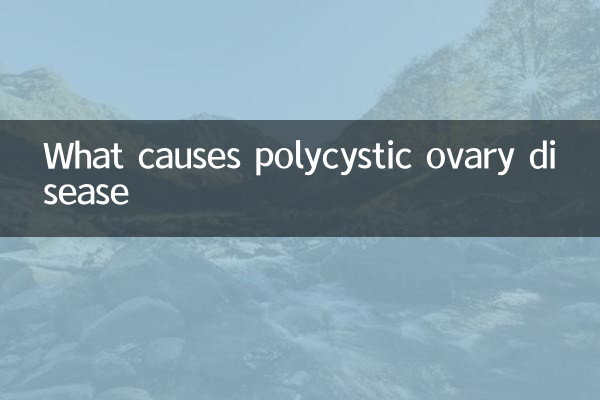What causes polycystic ovary disease
Polycystic ovary syndrome (PCOS) is a common endocrine and metabolic disease in women and has become a hot topic in the health field in recent years. This article will combine the hot discussions on the Internet in the past 10 days to analyze this disease for you in the form of structured data from the causes, symptoms, diagnosis and treatment.
1. The main causes of polycystic ovary disease

| Cause type | Specific performance | Related research data |
|---|---|---|
| genetic factors | Family aggregation is obvious | About 70% of patients have a family history |
| insulin resistance | Insulin utilization disorder in the body | Affects 50%-70% of patients |
| Abnormal hormone secretion | increased androgen levels | LH/FSH ratio≥2-3 |
| chronic inflammation | low-grade systemic inflammation | Elevated C-reactive protein |
| environmental factors | Effects of endocrine disruptors | Chemical substances such as bisphenol A |
2. Recent hot topics of discussion
According to network data analysis in the past 10 days, the following topics are the most discussed:
| Topic Category | Discussion popularity | Main point |
|---|---|---|
| PCOS and infertility | ★★★★★ | Accounts for 75% of anovulatory infertility |
| metabolic syndrome risk | ★★★★☆ | Diabetes risk increased by 4 times |
| mental health impact | ★★★☆☆ | Risk of depression increased 3 times |
| New treatment options | ★★★☆☆ | GLP-1 receptor agonist applications |
| Diet management controversy | ★★☆☆☆ | Discussion on the effectiveness of the ketogenic diet |
3. Typical symptoms
The symptoms of polycystic ovary disease are diverse:
| Symptom system | Specific performance | incidence |
|---|---|---|
| reproductive system | Oligomenorrhea/amenorrhea | 70%-80% |
| Skin manifestations | hirsutism, acne | 60%-70% |
| Metabolic abnormalities | central obesity | 50%-60% |
| Ultrasonic characteristics | polycystic ovarian changes | ≥12 follicles/ovary |
| Other performance | Alopecia, acanthosis nigricans | 30%-40% |
4. Evolution of diagnostic criteria
The diagnostic criteria have undergone several updates:
| diagnostic criteria | Release time | core points |
|---|---|---|
| NIH standards | 1990 | Clinical Kaohsiology + Ovulation Disorder |
| Rotterdam Standard | 2003 | Three items match two items |
| AE-PCOS | 2018 | Emphasis on Kaohsiung as a necessary condition |
| Chinese standards | 2020 | Combined with local population characteristics |
5. Comprehensive treatment plan
Current mainstream treatment options include many aspects:
| treatment goals | Specific measures | efficient |
|---|---|---|
| Improve insulin resistance | Metformin, lifestyle intervention | 60%-70% |
| Regulate menstrual cycle | Oral contraceptives, progestins | 80%-90% |
| Improving performance in Kaohsiung | Antiandrogens, laser hair removal | 50%-60% |
| Promote fertility | Ovulation induction treatment, IVF | 30%-40%/cycle |
| long term management | Weight control, metabolic monitoring | Need to be maintained for life |
6. Latest research progress
According to recent academic conferences and journal publications, PCOS research has made the following breakthroughs:
1.Gut flora association: It was found that the diversity of intestinal flora in PCOS patients is reduced, and specific bacterial species are related to androgen levels.
2.epigenetic mechanisms:Abnormal DNA methylation patterns may be an important link in the occurrence of diseases
3.New drug treatments: SGLT-2 inhibitors show promise in improving metabolic parameters
4.Accurate typing: Classification of four subtypes based on clinical and biochemical characteristics facilitates personalized treatment
7. Common misunderstandings among patients
Compiled according to data from the doctor-patient communication platform:
| Misunderstanding content | scientific explanation | frequency of occurrence |
|---|---|---|
| "Ovarian cyst requires surgery" | It is actually an immature follicle, not a true cyst | 45% |
| "Thin people don't get PCOS" | About 20% of patients have normal BMI | 30% |
| "It can be cured after treatment" | Currently it can only be controlled but not cured | 25% |
| "Must take birth control pills" | Choose a plan based on your treatment goals | 20% |
8. Prevention and management suggestions
1.lifestyle intervention: Moderate exercise (150 minutes per week) combined with diet control can improve symptoms by more than 50%
2.Regular monitoring: It is recommended to test metabolic indicators such as blood sugar and blood lipids every 6-12 months
3.psychological support: Joining a patient support group significantly improves treatment compliance
4.birth planning: It is recommended to complete the birth plan before the age of 35, as the success rate is higher
As the understanding of PCOS deepens, more and more studies focus on its long-term health effects. By correctly understanding the nature of the disease and adopting scientific management measures, patients can achieve a good quality of life. It is recommended that suspected patients seek medical advice from a reproductive endocrinology specialist as soon as possible to receive standardized diagnosis and treatment.

check the details

check the details